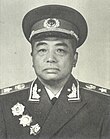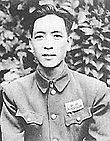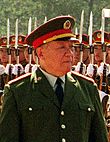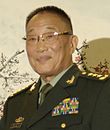Ministry of Defense of the People's Republic of China
The Ministry of Defense of the People's Republic of China ( Chinese 中国 国防部 , Pinyin Zhōngguó Guófángbù ) is a ministry that reports to the State Council . However , contrary to Western practice, the defense minister has no direct position in the chain of command ; this is reserved for the Central Military Commission , which is superordinate to the ministry . The Ministry of Defense takes on the diplomatic representation of the People's Liberation Army to the outside world.
history
precursor
The Communist Party of China has had a commission for military affairs since 1925 , which initially dealt with the political work among the cadets of the Whampoa Military Academy and the soldiers of the National Revolutionary Army of the Kuomintang . When, after the Nanchang Uprising on August 1, 1927, the breakaway Kuomintantg units led by Zhu De , Zhou Enlai and Liu Bocheng became the CCP's army, the military commission developed into the General Staff of the Red Army , and after the establishment of the Chinese Soviet Republic (中华 苏维埃 共和国, Pinyin Zhōnghuá Sūwéi'āi Gònghéguó ) on November 7, 1931, it was now called the "Central Revolutionary Military Commission", the Ministry of Defense of the young state, with departments for mobilization, training, etc.
After the victory over the Kuomintang, the " Revolutionary Military Commission of the People " with the "Joint Program of the Political Consultative Conference of the Chinese People", a kind of interim constitution, which was passed by the Political Consultative Conference of the Chinese People on September 29, 1949, was promoted raised by a constitutional body. Article 20 states there: “The People's Republic of China will set up uniform armed forces, namely the People's Liberation Army and the units of the People's Police. They are under the command of the People's Revolutionary Military Commission of the Central People's Government. ”This means that with the establishment of the People's Republic of China on October 1, 1949, the former party structure became a state authority. The head of the agency was Mao Zedong .
Development phase
On September 20, 1954, the 1,226 delegates to the 1st National People's Congress passed the first ordinary constitution of China. Article 42 states: "The chairman of the People's Republic of China has the supreme command of the armed forces of the country and is chairman of the National Defense Council." "Chairman of the People's Republic of China" (中华人民共和国 主席, Pinyin Zhōnghuá Rénmín Gònghéguó Zhǔxí ) was the name of the President at the time, ie Mao Zedong. Article 27 (6) stipulated that the President would propose his deputies and the remaining members of the Defense Council, who would then have to be confirmed by the National People's Congress and, under Article 28, may also be dismissed. The President was also elected and dismissed by the People's Congress. The "People's Revolutionary Military Commission" was abolished. The National Defense Council was only an advisory body; The People's Congress created a Ministry of Defense (国防部, Pinyin Guófángbù) for the administrative work of the then 4 million strong People's Liberation Army, which always had to be headed by an active officer. First Defense Minister became Lieutenant General Peng Dehuai on September 28, 1954 .
Peng Dehuai moved into an office in the three gates of honor building (三座 门, Pinyin Sān Zuò Mén ), 20 Vordere Jingshan Street , where the People's Revolutionary Military Commission and now the National Defense Council had been located since 1949. As one of his first official acts, in November 1954 he appointed seven experienced generals from the headquarters of the People's Liberation Army as state secretaries (副 部长, Pinyin Fù Bùzhǎng ) to the Ministry of Defense, who were to support him in setting up the new authority:
- Huang Kecheng (黄克诚, 1902–1986)
- Tan Zheng (谭政, 1906–1988)
- Xiao Jinguang (萧劲光, 1903-1989)
- Wang Shusheng (王树 声, 1905–1974)
- Xiao Ke (萧克, 1907-2008)
- Li Da (李 达, 1905–1993)
- Liao Hansheng (廖汉生, 1911-2006)
Peng Dehuai was already in 1931 deputy chairman of the "Central Revolutionary Military Commission" (中央 革命 军事 委员会, Pinyin Zhōngyāng Gémìng Jūnshì Wěiyuánhuì ) of the Chinese Soviet Republic, that is, "Vice Minister of Defense", and knew how a defense ministry had to be organized in order to ensure efficient processes. For his current office, however, he was guided by the organizational structure of the Soviet Ministry of Defense and created 8 departments:
- General Staff (总参谋部, Pinyin Zǒngcānmóubù )
- Main Department for Supervision of Training (训练 总监 部, Pinyin Xùnliàn Zǒngjiānbù )
- Department for the Control of the Armed Forces (武装力量 监察部, Pinyin Wǔzhuāng Lìliàng Jiānchábù )
- Political Department (总政治部, Pinyin Zǒngzhèngzhìbù )
- Main Department for Management Affairs (总 干部 部, Pinyin Zǒnggànbùbù )
- Main Logistics Department (总后勤部, Pinyin Zǒnghòuqínbù )
- Main Finance Department (总 财务 部, Pinyin Zǒngcáiwùbù )
- Main witness office (总 军械 部, Pinyin Zǒngjūnxièbù )
While the Ministry of Defense in the Soviet Union had actual authority to command, in China there was also the "Central Military Commission" established by the Politburo of the Communist Party of China on September 28, 1954, the day Peng Dehuai was appointed Defense Minister, and headed by Mao Zedong Communist Party of China "(中共中央 军事 委员会, Pinyin Zhōng Gòng Zhōngyāng Jūnshì Wěiyuánhuì), which is located below the Politburo or the Secretariat of the Communist Party of China (中国 共产党 中央 书记处, Pinyin Zhōngguó Gòngchǎndǎng Zhōngyāng Shūngjìchù). The party's newly created ZMK was tasked with leading the People's Liberation Army and the other armed units of China ( People's Militia and People's Armed Police ). In general, the decisions of the Politburo, the Secretariat and the party ZMK itself should be passed on to the units under the name of the Central Military Commission of the Communist Party via internal channels (内部 系统, Pinyin nèibù xìtǒng). Orders and directives that needed to be published were done under the name of the Council of State or the Ministry of Defense. Since Peng Dehuai, in addition to his work as defense minister, also headed the day-to-day business of the party ZMK as vice-chairman, this was in itself easy to do.
The friction losses arose in the Ministry of Defense itself. Since it was nowhere specified which orders, instructions and requirements required the signature of the minister and which could be issued directly by the ZMK, Peng Dehuai and General Su Yu (粟裕, 1907–1984), the Chief of the General Staff, repeatedly to conflict. Finally, Su Yu drew up a draft for "Guidelines regarding the official duties of the Ministry of Defense and the General Staff" (国防部 与 总参 职责 条例), which he submitted to the Central Military Commission for resolution at its meeting on March 16, 1955. However, the ZMK could not agree on binding rules. Only when Su Yu was replaced as Chief of Staff on September 19, 1958 and received a post as Secretary of State in the Ministry of Defense, while General Huang Kecheng gave up his post of State Secretary in October 1958 and took over the management of the General Staff, did calm return to the house.
Barely a year after this castling, in August 1959, Peng Dehuai was dismissed from his office on the pretext of collaboration with the Soviet Union because of his fierce criticism of Mao in connection with the Great Leap Forward . On September 17, 1959, Field Marshal Lin Biao was appointed as the new defense minister at the suggestion of Mao Zedong ; on September 26th, Lin took over Peng Dehuai's post as vice chairman of the CCP Central Military Commission, where he, like his predecessor, ran the day-to-day business.
modernization
Lin Biao increased the number of state secretaries in the Ministry of Defense to 11, but at the same time he pushed ahead with the modernization of the People's Liberation Army initiated by his predecessor. On August 6, 1956, Peng Dehuai had set up the so-called "Fifth Office" (第五 局, Pinyin Dìwǔ Jú ) in the Ministry of Defense under the direction of Zhong Fuxiang (钟 夫 翔, 1911–1992), with Prof. Qian Xuesen from the California Institute of Technology as chief engineer. On October 8, 1956, the "5th Research Institute of the Ministry of Defense" (国防部 第五 研究院, Pinyin Guófángbù Dìwǔ Yánjiūyuàn ) was founded in Beijing, which took over the staff of the Fifth Office on March 1, 1957. Qian Xuesen became head of the institute, which dealt with the development of the Chinese atomic bomb and launchers for nuclear weapons. This did not meet with unreserved approval in the party. In November 1961, Zhang Aiping , deputy chief of the general staff, together with Qian Xuesen, deputy chairman of the "Chinese People's Liberation Army Commission for Science and Technology in National Defense" (中国人民解放军 国防 科学 技术 委员会) and deputy head of November 8, 1961 reported established "Defense Industry Offices at the State Council" (国务院 国防 工业 办公室) that a number of members of the CCP Central Committee had expressed their wish to abandon the nuclear weapons program. However, Lin Biao replied that work on the atomic bomb had to continue "even if we had to detonate it with firewood." At that time, Field Marshal Lin was - apart from his posts as Defense Minister and Vice Chairman of the ZMK - Vice Chairman of the Central Committee of the CCP and Vice Chancellor of the People's Republic of China, and thus the second most powerful man in the state after Mao Zedong. The nuclear weapons program continued, and on October 16, 1964, the first Chinese atomic bomb was successfully detonated at the Lop Nor nuclear weapons test site under the supervision of Zhang Aiping.
Lin Biao's reputation rose. At the 9th CCP Congress, held in Beijing from April 1 to 24, 1969, the 1,512 delegates, 3/4 of them from the People's Liberation Army, formally wrote in the party statutes that Lin Biao was Mao Zedong's designated successor. But then there was a falling out with Mao, and in the early hours of the morning of September 13, 1971, Lin was killed when his plane crashed while fleeing to the Soviet Union. Since the highest level of command in China came from the Central Military Commission, the post of defense minister was initially not filled again. However, the administrative apparatus of the ministry, and especially the research institutes belonging to the ministry, remained in place. At the end of 1971, the Ministry of Defense had the following research facilities:
- , 5. Research Institute of Defense (国防部第五研究院, Pinyin Guófángbù Dìwǔ Yánjiūyuàn), nuclear weapons and missile technology since 1999, China Aerospace Science and Technology Corporation called
- ,, 6th Research Institute of Defense (国防部第六研究院, Pinyin Guófángbù Dìliù Yánjiūyuàn) Air Force since 2008 Aviation Industry Corporation of China called
- ,, 7th Research Institute of Defense (国防部第七研究院, Pinyin Guófángbù Diqi Yánjiūyuàn) Marine since 1999 China Shipbuilding Industry Corporation called
- 10. Research Institute of the Ministry of Defense (国防部 第十 研究院, Pinyin Guófángbù Dìshí Yánjiūyuàn), tanks, part of the Military College of the People's Liberation Army since 2016
From January 13 to 17, 1975, after a ten-year break (they were in the middle of the Cultural Revolution ), the National People's Congress met again and passed a new constitution, Article 15 of which stated that the Chairman of the Chinese Communist Party, Mao Zedong, commanded the armed forces, that is, the People's Liberation Army and the People's Militia . In addition, on January 17, 1975, the parliament appointed Ye Jianying , vice chairman of the CPCH Central Committee and appointed field marshal in 1955, as defense minister. Less than two years later, on October 6, 1976, Ye and the new party leader Hua Guofeng - Mao had died on September 9, 1976 - had the gang of four arrested, officially ending the Cultural Revolution.
The Ministry of Defense finally found itself in calm waters. After seven other constitutional changes currently (2018), the Central Military Commission of the People's Republic of China , the high command of the armed forces. The research institutes belonging to the ministry were outsourced in 1999 and today, with the exception of the 10th, which deals with the development and improvement of armored vehicles in Shijiazhuang under the umbrella of the Military College of the People's Liberation Army, operate as so-called " Centrally Managed Enterprises " (中央 管理 企业, Pinyin Zhōngyāng Guǎnlǐ Qǐyè ), that is, they are subordinate to the State Council of the People's Republic of China , are 100% state-owned and operate externally as a conglomerate (集团公司, Pinyin Jítuán Gōngsī ), with the expectation of working cost-effectively, somewhat comparable to the Deutsche Bahn . End 1999, the company moved the Ministry of Defense in the newly built VBA-building in the Fuxing Road 7 instead, to the south of Beijing Municipality Haidian , where as honorary gates three-building, also the Central Military Commission is housed in the old.
structure
Today the Ministry of Defense of the People's Republic of China has its own civil service, but the actual work is carried out by departments of the Central Military Commission . Currently, i.e. since the military reform that came into force on January 1, 2016, the Ministry of Defense has 4 departments:
- Public Relations Office (新闻 局, Pinyin Xīnwén Jú ). The tasks of this department are actually carried out by the Office for International Military Cooperation of the Central Military Commission (中央军委 国际 军事 合作 办公室, Pinyin Zhōngyāng Jūnwěi Guójì Jūnshì Hézuò Bàngōngshì ).
- Office for International Military Cooperation (国际 军事 合作 办公室, Pinyin Guójì Jūnshì Hézuò Bàngōngshì ). The tasks of this department are actually carried out by the Office for International Military Cooperation of the Central Military Commission (中央军委 国际 军事 合作 办公室, Pinyin Zhōngyāng Jūnwěi Guójì Jūnshì Hézuò Bàngōngshì ).
- Recruiting office (征兵 办公室, Pinyin Zhēngbīng Bàngōngshì ). The tasks of this department are actually performed by the chancellery of the Department of Popular Mobilization of the Central Military Commission (中央军委 国防 动员 部 办公厅, Pinyin Zhōngyāng Jūnwěi Guófáng Dòngyuánbù Bàngōngtīng ).
- Office for peacekeeping operations within the framework of the United Nations (维 和 事务 办公室, Pinyin Wéihé Shìwù Bàngōngshì ). The tasks of this department are actually carried out by the intelligence service of the Joint General Staff at the Central Military Commission (中央军委 联合 参谋部 情报 局, Pinyin Zhōngyāng Jūnwěi Liánhé Cānmóubù Qíngbàojú ).
Defense Minister
 |
Lieutenant General Peng Dehuai | September 28, 1954 - August 16, 1959 |
 |
Field Marshal Lin Biao | September 17, 1959 - September 13, 1971 |
 |
Ye Jianying | January 17, 1975 - February 26, 1978 |
 |
Xu Xiangqian | February 26, 1978 - March 6, 1981 |
 |
Geng Biao | March 6, 1981 - November 19, 1982 |
 |
Zhang Aiping | November 19, 1982 - April 12, 1988 |
 |
General Qin Jiwei | April 12, 1988 - March 29, 1993 |
 |
General Chi Haotian | March 29, 1993 - March 17, 2003 |
 |
General Cao Gangchuan | March 17, 2003 - March 17, 2008 |
 |
General Liang Guanglie | March 17, 2008 - March 16, 2013 |
 |
General Chang Wanquan | March 16, 2013 - March 19, 2018 |
 |
General Wei Fenghe | since March 19, 2018 |
Note: In 1965 the ranks of the People's Liberation Army were abolished, reintroduced in September 1988. During this time, superiors were addressed with the position , not "Lieutenant Li" but "Platoon leader Li", not "Field Marshal Ye" but "Minister Ye".
Web links
- Official website (English).
- Description at SinoDefence.com (English)
Individual evidence
- ↑ Stephen Uhalley Jr .: A History of the Chinese Communist Party. Hoover Institution Press, Stanford 1988, pp. 34-46.
- ↑ 1949 年 《中国 人民 政治协商会议 共同 纲领》 全文. In: https://news.qq.com . November 17, 2011, accessed November 4, 2018 (Chinese).
- ^ General guidelines of the Political Consultative Council. In: http://www.verfassungen.net . September 29, 1949, accessed November 4, 2018 .
- ↑ Stephen Uhalley Jr .: A History of the Chinese Communist Party. Hoover Institution Press, Stanford 1988, p. 84.
- ↑ 中华人民共和国 宪法 (1954 年). In: http://www.npc.gov.cn . September 20, 1954, accessed November 6, 2018 (Chinese).
- ↑ Constitution of the People's Republic of China. In: http://www.verfassungen.net . September 20, 1954, accessed November 6, 2018 .
- ↑ Stephen Uhalley Jr .: A History of the Chinese Communist Party. Hoover Institution Press, Stanford 1988, p. 219.
- ↑ The name of the building derives from the three to Dagao temple belonging honor gates from that spanned there until 1955 the street.
- ↑ 林蕴晖: 朱可夫 事件 与 彭德怀 庐山 罢官. In: https://news.qq.com . July 29, 2010, Retrieved November 20, 2018 (Chinese).
- ↑ Stephen Uhalley Jr .: A History of the Chinese Communist Party. Hoover Institution Press, Stanford 1988, pp. 123-125.
- ↑ 1959 年 9 月 26 日. In: http://www.hprc.org.cn . July 1, 2015, accessed November 21, 2018 (Chinese).
- ↑ 梅世雄 、 毛 俊: 第 一个 导弹 火箭 研究 机构 —— 国防部 五 院 : 中国 航天 梦 的 起点. In: xinhuanet.com. July 10, 2016, accessed November 21, 2018 (Chinese).
- ↑ 孟昭瑞: 核 工业 发展 50 年 的 巨变 : 中国 蘑 菰 云.辽宁 人民出版社, 沈 阳 2008, 第 26 节.
- ↑ Stephen Uhalley Jr .: A History of the Chinese Communist Party. Hoover Institution Press, Stanford 1988, pp. 155f.
- ↑ Stephen Uhalley Jr .: A History of the Chinese Communist Party. Hoover Institution Press, Stanford 1988, pp. 158-167
- ↑ As can be seen from the numbers assigned after the date of establishment, the military in China still had other research institutes. However, these were not directly subordinate to the Ministry of Defense, but to other agencies and authorities, such as the 4th Research Institute (Air Protection) of the General Staff, since January 1, 2016 the Central Military Commission. Compare : 总参谋部 工程兵 第四 设计 研究院 到 东城 区 民防 局 调研. In: bjdch.gov.cn. August 14, 2011, accessed November 24, 2018 (Chinese).
- ↑ 中华人民共和国 宪法 (1975 年). In: npc.gov.cn. January 17, 1975. Retrieved November 24, 2018 (Chinese).
- ↑ Constitution of the People's Republic of China. In: verfassungen.net. January 17, 1975. Retrieved November 24, 2018 .
- ↑ Stephen Uhalley Jr .: A History of the Chinese Communist Party. Hoover Institution Press, Stanford 1988, pp. 177 and 185f.
- ^ White Paper of the Armed Forces of the People's Republic of China. In: http://german.china.org.cn/ . Retrieved October 28, 2018 .
- ↑ Minnie Chan: PLA to announce overhaul: five 'strategic zones' will replace regional commands, most army HQ to be scrapped. In: https://www.scmp.com . December 20, 2015, accessed November 8, 2018 .


